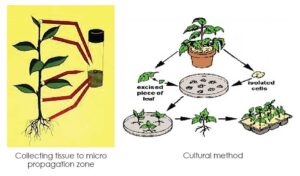Palm Perfection Unleashed: Cultivating Ornamental Beauty
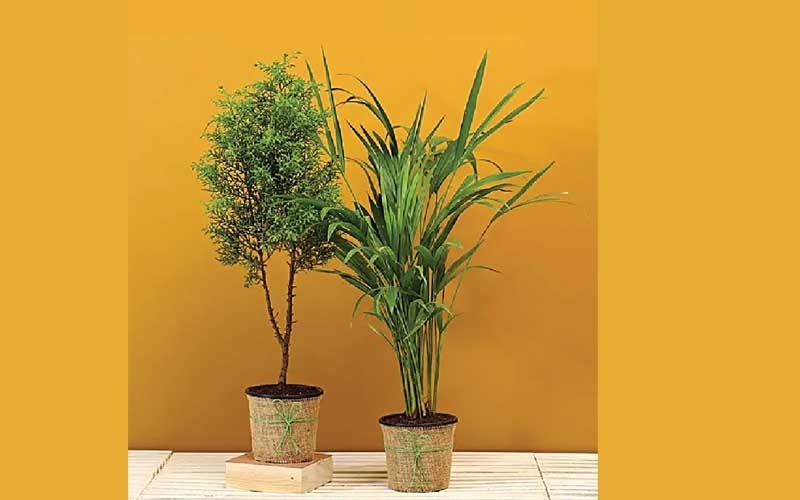
The article will take you on a green journey of the ornamental beauty of Palm, where you will get insights into its varieties, growth habits, unique features, and characteristics.
Dr. Amar Singh
Introduction
Ornamental palm plants are a diverse group of plants belonging to the family Arecaceae, commonly known as the palm family. They are characterized by their long, slender trunks (stems) topped with large, fan-shaped or feather-like leaves (fronds). These plants are renowned for their graceful appearance, tropical vibes, and ability to add a touch of elegance to any setting.
History
The use of palm plants for decorative purposes dates back to ancient times. Palms were highly prized by civilizations such as the ancient Egyptians, Greeks, and Romans, who recognized their beauty and symbolism. In ancient Egypt, palm branches were used in religious ceremonies and were a symbol of victory and eternal life.
During the Roman Empire, palm trees were often featured in gardens and landscapes, and they symbolized triumph, wealth, and luxury. The Romans also introduced various palm species to Europe through their extensive trade routes, contributing to the spread and popularity of ornamental palms in the region.
In the 19th century, with the expansion of global trade and exploration, palm plants gained popularity worldwide. European explorers and plant collectors brought back exotic palm species from tropical regions, and these plants became highly sought after by horticulturists and garden enthusiasts.
Uses of Palm
Palm trees have various uses in India. Here are some common uses of palm in different aspects:
I. Culinary uses: Palm trees provide several edible products in India. The most notable is the coconut palm (Cocos nucifera), which is widely cultivated for its nutritious coconut fruit. Coconut is used in various Indian cuisines for cooking, as a flavoring agent, and in the preparation of coconut-based sweets and snacks.
II. Palm sugar: In some parts of India, palm trees such as the Palmyra palm (Borassus flabellifer) and Date palm (Phoenix dactylifera) are tapped for their sap, which is then processed into palm sugar or jaggery. Palm sugar is a natural sweetener used in traditional Indian sweets, beverages, and desserts.
III. Thatching and Roofing: The leaves of various palm species are used for thatching and roofing purposes in rural areas. The leaves of palms like the Coconut palm and Palmyra palm are woven together to create durable and weather-resistant roofs for houses and huts.
IV. Handicrafts: Palm leaves are widely used in India for making handicrafts, baskets, mats, and various woven products. Skilled artisans weave intricate designs using palm leaves, and these crafts are popular souvenirs and traditional items.
V. Medicinal uses: Certain parts of palm trees are used in traditional medicine. For example, the Palmyra palm has medicinal properties, and its roots, leaves, and fruits are used in Ayurvedic preparations for various ailments.
VI. Palm oil: While palm oil is not native to India, it is imported and widely used in the country. Palm oil is used as a cooking oil, in food processing industries, and in the production of various household and cosmetic products.
VII. Landscaping and Ornamental purposes: Palms, such as the Areca palm (Areca catechu) and King palm (Archontophoenix cunninghamiana), are extensively used in landscaping and as ornamental plants in gardens, parks, and urban areas.
These are just a few examples of the uses of palm trees in India. Palms play a significant role in the cultural, economic, and traditional practices of the country.

Some important Ornamental Palm plant for decoration
1. Areca Palm (Dypsis lutescens):
Known for its feathery, arching fronds, the Areca Palm is widely used in landscape design to create a tropical atmosphere. It adds a touch of elegance and lushness to gardens and outdoor spaces.
2. Majesty Palm (Ravenea rivularis):
With its tall stature and large, fan-shaped fronds, the Majesty Palm makes a dramatic statement in landscape design. It is often used as a focal point or to provide vertical interest in gardens or large outdoor areas.
3. Kentia Palm (Howea forsteriana): It is a popular for landscape decoration due to its appearance, slender trunk, and ability to tolerate various light conditions. It is often used in shaded areas, courtyards, or as an accent plant in tropical-themed landscapes.
4. Pygmy Date Palm (Phoenix roebelenii): This small-sized palm is ideal for landscape decoration in compact spaces or as a potted plant. It features delicate, feather-like fronds and adds a tropical touch to gardens, patios, or poolside areas.
5. European Fan Palm (Chamaerops humilis): It is native to the Mediterranean region and is known for its fan-shaped leaves and bushy growth. It is a cold-hardy palm that adds a touch of exoticism to landscapes and is used in Mediterranean-style gardens.
6. Bottle Palm (Hyophorbe lagenicaulis): With its unique, swollen trunk resembling a bottle, the Bottle Palm is a striking choice for landscape decoration. It is often used as a focal point or as a specimen plant in gardens or tropical-themed landscapes.
7. Pindo Palm (Butia capitata): This palm features gracefully arching, silver-green fronds and a sturdy trunk. It is commonly used in landscape design to add a touch of elegance and a subtropical vibe to gardens, coastal areas, or as an accent plant.
8. Sago Palm (Cycas revoluta): Although not a true palm but a cycad, It is used as an ornamental plant in landscape design due to its unique appearance and ability to tolerate a wide range of conditions. It adds a touch of prehistoric charm to gardens or as a focal point in rock gardens.
9. Windmill Palm (Trachycarpus fortunei): Known for its distinctive hairy trunk and large, fan-shaped leaves, the Windmill Palm is a popular choice for landscape design. It is cold-hardy and adds a touch of elegance to gardens, pathways, or as an accent plant.
10. Bismarck Palm (Bismarckia nobilis): This palm is prized for its large, blue-silver fronds and striking symmetrical form. It is often used as a focal point in landscape design, creating a dramatic visual impact in gardens or open spaces.
11. Foxtail Palm (Wodyetia bifurcata): With its unique foxtail-like fronds, the Foxtail Palm adds a tropical touch to landscape designs. It is commonly used as a specimen plant or in groupings to create a focal point or provide a vertical element.
12. Christmas Palm (Adonidia merrillii): This palm gets its name from the clusters of red fruits that resemble Christmas ornaments. It is often used in landscape design to add a splash of color and tropical charm to gardens, entryways, or as a potted plant.
13. Needle Palm (Rhapidophyllum hystrix): The Needle Palm is known for its sharp, needle-like leaves and rugged appearance. It is often used in landscape design to create a natural, tropical look and is well-suited for coastal or woodland settings.
14. Chinese Fan Palm (Livistona chinensis): With its large, fan-shaped leaves and slender trunk, the Chinese Fan Palm is a versatile choice for landscape design. It is often used as an accent plant or in groupings to create a tropical ambiance in gardens, parks, or along streetscapes.
15. Silver Palm (Coccothrinax argentata): This palm features silvery-blue foliage and a slender trunk. It is used in landscape design to add a touch of elegance and a coastal aesthetic to gardens, resorts, or seaside locations.
16. Spindle Palm (Hyophorbe verschaffeltii): With its distinctive swollen trunk and feathery leaves, the Spindle Palm is a unique addition to landscape designs. It is often used as a focal point or in groupings to create visual interest and tropical vibes.
These palm plants offer a range of textures, colors, and forms, allowing landscape designers to create diverse and visually captivating outdoor spaces. As always, it’s essential to consider the specific requirements of each palm species in terms of sunlight, water, soil conditions, and cold hardiness when incorporating them into landscape designs.
Light requirement
The light requirements for ornamental palm varieties can vary depending on the specific species. However, most ornamental palms thrive in bright, indirect light. Here are some general guidelines for the light requirements of ornamental palms:
I. Bright indirect light: Most ornamental palms prefer bright, indirect light. They thrive in locations where they receive filtered sunlight or partial shade throughout the day. Avoid placing them in areas with direct, intense sunlight, as it can scorch the leaves and cause damage.
II. Morning or afternoon Sun: Some ornamental palms can tolerate a few hours of direct morning or afternoon sun, especially if they are acclimated gradually. However, prolonged exposure to intense sunlight can stress the palm and lead to leaf burn.
III. Shade tolerance: Many ornamental palm varieties have a degree of shade tolerance, allowing them to grow in areas with lower light levels. However, too much shade can result in lanky growth and reduced overall vigor. It is important to strike a balance between light and shade to ensure optimal growth and appearance.
IV. Adjusting light levels: If you are growing ornamental palms indoors or in areas with limited light, you can supplement the available light with artificial lighting, such as fluorescent or LED grow lights. This can help provide the necessary light intensity and duration for healthy growth.
Soil
When preparing a soil mixture for ornamental palm plants, it’s important to create a well-draining medium with an appropriate pH level. Here’s a detailed description of the soil mixture components and pH considerations for ornamental palms:
Soil mixture components
I. Sandy loam: Start with a base of sandy loam soil, which provides good drainage while retaining some moisture. Sandy loam consists of a balanced combination of sand, silt, and clay particles, offering a loose texture that promotes root penetration and aeration.
II. Organic matter: Incorporate organic matter into the soil mixture to improve its fertility, water-holding capacity, and nutrient content. Well-rotted compost, aged manure, or leaf mold are commonly used organic amendments. Aim for a ratio of approximately 20-30% organic matter in the soil mixture.
III. Perlite or Vermiculite: Add perlite or vermiculite to the soil mixture to enhance its drainage and aeration properties. These lightweight materials improve soil structure, prevent compaction, and promote root health.
IV. Coarse sand: Include coarse sand in the soil mixture to improve drainage further. The sand particles should be larger in size and have angular edges, aiding in water movement through the soil and preventing waterlogging.
V. Soil pH considerations: The ideal pH range for ornamental palm plants generally falls between slightly acidic to neutral, typically around pH 6.0 to 7.5. However, specific palm species may have slight variations in their pH preferences. Here are some guidelines for adjusting the soil pH:
VI. Lowering pH (for more acidic conditions)
Elemental sulfur: Add elemental sulfur to the soil mixture according to the recommended application rate, based on the soil test results. Sulfur helps lower the pH over time.
VII. Raising pH (for more alkaline conditions)
Agricultural lime or Dolomite lime: Incorporate agricultural lime or dolomite lime into the soil mixture following the recommended application rate. These amendments help raise the pH and make the soil more alkaline.
It’s crucial to note that adjusting soil pH is a gradual process, and it’s recommended to monitor the pH levels periodically and make adjustments accordingly. Conducting a soil test before planting will provide specific guidance on the current pH of your soil and whether any adjustments are necessary.
Fertilizer or nutrient requirement of Palm plant
The nutrient requirements for palm plants can vary depending on the specific species and the existing nutrient levels in the soil. However, here are some general guidelines for the quantity of different nutrients typically needed for palm plants:
I. Nitrogen (N): Nitrogen is essential for palm growth and overall plant health. A balanced palm fertilizer should contain a moderate to high level of nitrogen. The recommended nitrogen content in the fertilizer can range from 12% to 18% or higher. Follow the manufacturer’s instructions for application rates based on the specific fertilizer you are using.
II. Phosphorus (P): Phosphorus promotes root development, flowering, and fruiting in palm plants. Palm fertilizers often have a lower phosphorus content compared to nitrogen. Look for a fertilizer with a phosphorus content of around 6% to 10%. Adjust the application rates based on the specific nutrient needs of your palm species.
III. Potassium (K): Potassium helps with overall plant growth, disease resistance, and stress tolerance. Palm fertilizers generally have a higher potassium content compared to nitrogen and phosphorus. Look for a fertilizer with a potassium content of around 12% to 20%. Adjust the application rates based on the specific nutrient needs of your palm species.
IV. Micronutrients: Palm plants also require trace elements or micronutrients in smaller quantities. These include iron (Fe), manganese (Mn), zinc (Zn), Copper (Cu), boron (B), molybdenum (Mo), and others. While the quantities of micronutrients in palm fertilizers are relatively small, they play a crucial role in overall plant health. Some palm fertilizers may include micronutrients in their formulations, or you can supplement with a separate micronutrient product if deficiencies are observed.
Planting of Palm
When planting ornamental palm trees, there are several important steps to ensure their successful establishment and growth. Here’s a guide for planting ornamental palm trees:
I. Selecting the Palm tree: Choose a healthy, well-suited palm tree species for your specific climate and growing conditions. Consider factors such as sun exposure, temperature tolerance, and soil requirements. Also, check the size of the mature palm to ensure it fits your planting location.
II. Choosing the planting location: Select a planting location that provides adequate space for the palm to grow to its full size without obstruction. Ensure the area has proper sunlight, appropriate soil conditions, and sufficient drainage. Consider the palm’s ultimate height and spread when determining the spacing between multiple palm trees.
III. Digging the hole: Dig a hole for the palm that is wide and deep enough to accommodate the root ball comfortably. The width of the hole should be two to three times wider than the root ball, and the depth should be slightly shallower than the height of the root ball. Avoid digging the hole too deep, as this can lead to issues with water drainage.
IV. Soil preparation: Prepare the soil in the planting hole by loosening it and breaking up any clumps. If the soil is heavy or poorly draining, consider amending it with organic matter, such as compost, to improve its structure and drainage.
V. Planting the Palm: Carefully remove the palm tree from its container or burlap, taking care not to damage the roots. Place the root ball in the center of the planting hole, ensuring that the top of the root ball is level with or slightly above the surrounding soil. Backfill the hole with the excavated soil, gently firming it around the roots to eliminate air pockets.
VI. Watering: After planting, thoroughly water the palm to settle the soil and ensure good root-to-soil contact. Provide regular irrigation during the establishment period to keep the soil moist but not waterlogged. Adjust the watering frequency based on the weather conditions and moisture retention capacity of the soil.
VII. Mulching: Apply a layer of organic mulch, such as wood chips or shredded leaves, around the base of the palm tree. Mulching helps conserve soil moisture, regulate temperature, and suppress weed growth. Leave a gap between the mulch and the trunk to prevent moisture-related issues and potential rotting.
VIII. Staking (if necessary): Some palm trees may require staking for support during the initial establishment period, especially if they have a slender trunk. Use sturdy stakes placed away from the root ball and secure the palm with soft ties to avoid damaging the trunk. Remove the stakes once the palm has established and can support itself.
IX. Maintenance and Care: Provide ongoing care for the planted palm, including regular watering, fertilization based on soil tests and palm species requirements, and monitoring for any signs of pests or diseases. Prune dead or damaged fronds as needed, but avoid over-pruning, as healthy fronds contribute to the palm’s overall vitality.
Following these general steps will help ensure a successful planting process and promote the healthy growth of your ornamental palm tree.
Irrigation and micro irrigation of Palm plant
Irrigation plays a crucial role in the proper growth and health of palm plants, especially in areas where natural rainfall is insufficient or inconsistent. Two common methods of irrigation used for palm plants are conventional irrigation and micro-irrigation.
Conventional irrigation: Conventional irrigation refers to the traditional method of watering plants using sprinklers or flood irrigation. When using conventional irrigation for palm plants, there are a few considerations to keep in mind:
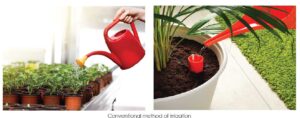
Micro-irrigation: Micro-irrigation, also known as drip irrigation, is a water-efficient method that delivers water directly to the plant’s root zone, minimizing water wastage. Micro-irrigation can be beneficial for palm plants, particularly in regions with limited water availability. Here’s how it can be implemented:
I. Drip emitters: Install drip emitters or micro-sprinklers near the base of each palm tree. These emitters deliver water slowly and directly to the plant’s root zone, ensuring efficient water use and reducing the risk of water loss through evaporation.
II. Watering schedule: Determine the appropriate watering schedule based on factors such as temperature, humidity, and soil moisture. The frequency and duration of watering will depend on the specific needs of the palm species, as well as the environmental conditions.
III. Zone design: Divide the planting area into irrigation zones based on the water requirements of palm trees. This allows for better control over water distribution and prevents overwatering or under watering of individual trees.
IV. System monitoring: Regularly inspect the micro-irrigation system to ensure proper functioning of emitters, avoid clogging, and make any necessary adjustments. Monitor soil moisture levels to determine if adjustments to the watering schedule are needed.
V. Micro-irrigation systems can be automated using timers and sensors to ensure precise and efficient water delivery. This method helps conserve water by reducing runoff, evaporation, and overspray.
Both conventional irrigation and micro-irrigation can be effective for watering palm plants. The choice of irrigation method will depend on factors such as water availability, water conservation goals, and the specific needs of the palm species being cultivated. It’s important to monitor the plants’ water requirements and adjust the irrigation accordingly to ensure optimal growth and health.
Propagation and micro propagation in Palm
Propagation of palm plants can be achieved through several methods, including seed propagation, division, and tissue culture. Here’s an overview of each propagation method:
Seed propagation: Seeds are the most common and natural way to propagate palm plants. Here are the general steps involved in seed propagation:
I. Seed collection: Collect ripe, fresh seeds from mature palm trees. Ensure that the seeds are fully mature and have not dried out.
II. Seed preparation: Clean the seeds by removing any pulp or fruit residue. Some palm seeds may require scarification (nick or file the hard seed coat) or soaking in water to enhance germination.
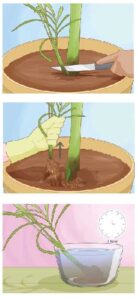
Germination: Plant the prepared seeds in a well-draining seed-starting mix. Maintain consistent moisture and provide warmth. Depending on the palm species, germination can take weeks to several months.
III. Transplanting: Once the seedlings have developed several leaves, they can be carefully transplanted into individual pots or a suitable planting location. Continue to provide proper care and monitor their growth.
Division of suckers: Certain palm species can be propagated through division, which involves separating an existing palm plant into multiple smaller plants. Here’s how to propagate through division:
I. Choose a mature palm plant with multiple stems or offsets (known as suckers or pups) emerging from the base.
II. Dig around the base of the palm to expose the root system and the attached offsets.
III. Gently separate the offsets from the main plant, ensuring that each division has its own set of roots.
IV. Plant the divided sections into separate containers or suitable planting locations, using a well-draining soil mix.
V. Provide proper care, including watering, light, and nutrients, to support the growth of the divided palm plants.
Tissue culture
Tissue culture, also known as micro propagation, is a more advanced propagation method suitable for large-scale production of identical palm plants. It involves taking small tissue samples from a parent palm and growing them in a sterile laboratory environment. Here’s a simplified overview of the tissue culture process:
I. Tissue collection: Collect a small tissue sample from a healthy and disease-free parent palm.
II. Surface sterilization: Treat the tissue sample with disinfectants to remove any microorganisms and contaminants.
III. Growth Medium: Place the sterilized tissue sample in a nutrient-rich growth medium in a sterile container.
IV. Multiplication: Allow the tissue sample to grow and multiply in the growth medium, producing multiple plantlets.
V. Acclimatization: Transfer the plantlets to a controlled environment for acclimatization and root development.
VI. Transplanting: Once the plantlets have developed roots, they can be transplanted into individual pots or suitable planting locations.
Each propagation method has its advantages and considerations. Seed propagation is the most natural but may result in variations in plant characteristics. Division allows for the rapid multiplication of specific palm plants. Tissue culture ensures uniformity but requires specialized facilities and expertise.
It’s important to research and understand the specific requirements and techniques for propagating the palm species you intend to propagate, as there may be variations in the propagation methods and success rates among different palm species.
How to decorate with palm plants
Decorating indoor and outdoor landscapes in India with palm plants can create a beautiful tropical atmosphere. Here are some tips on how to decorate with palm plants in both indoor and outdoor 11.1 Plant Decoration in landscape:
Indoor decoration
I. Choose suitable Palm varieties: Select palm varieties that thrive indoors in India’s climate. Some popular choices include Areca Palm, Kentia Palm, Parlor Palm, and Lady Palm. Ensure the palm species you choose can adapt to the lighting conditions of your indoor space.

II. Placement: Place your indoor palm plants near windows or in areas with bright, indirect light. Palms generally require good light, but direct sunlight can scorch their leaves. Find a balance between sufficient light and protection from harsh rays.
III. Decorative containers: Opt for decorative pots or planters that match your interior style. Consider using colorful ceramic pots, woven baskets, or wooden containers. Ensure the pots have drainage holes to prevent water accumulation.
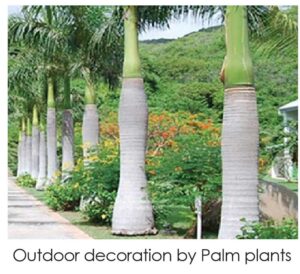
IV. Incorporate accessories: Enhance the tropical feel by adding accessories. Hang wall art or photographs depicting palm trees, place beach-themed decor items, or use tropical-inspired cushions, rugs, or curtains to complement the palm plants.
V. Grouping and Layering: Create a lush indoor oasis by grouping multiple palm plants together. Vary the heights, leaf shapes, and textures to add visual interest. Place taller palms towards the back and shorter ones towards the front for depth.
Outdoor decoration
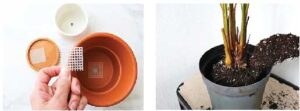
I. Suitable Palm species: Choose palm varieties that thrive in the specific region of India where you live. Some popular palm trees for outdoor landscapes in India include Coconut Palm, Date Palm, Fan Palm, Fox tail palm, Bismarkia Palm and Queen Palm. Research which palms are best suited to your specific climate and soil conditions.
II. Select the right location: Consider the sunlight and wind exposure in your outdoor space. Most palm trees prefer full to partial sunlight. Ensure the selected area has well-drained soil and enough space for the palm tree to grow to its mature size.
Repotting Palm plants
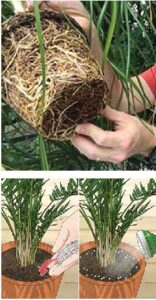
I. Timing: Repot palm plants when they have outgrown their current pots or when the root ball becomes too compacted. Spring is generally the best time for repotting.
II. Selecting a new pot: Choose a pot that is one size larger than the current pot to allow for root growth. Ensure that the new pot has drainage holes.
III. Repotting process: Follow the same steps as potting, starting with preparing the new pot and soil mix. Gently remove the palm plant from its current pot, loosen the root ball, and place it in the new pot at the appropriate level. Backfill with fresh soil mix, firm the soil, and water thoroughly.
IV. Pruning roots (if necessary): If the roots are excessively circling or root-bound, consider pruning or untangling them before repotting. This encourages new root growth and prevents potential issues.
V. Aftercare: Place the repotted palm plant in a suitable location with the right light and temperature conditions. Monitor the plant’s water needs, provide proper fertilization, and ensure adequate drainage to support its growth.
VI. Remember to handle the palm plant gently during potting or repotting to avoid damaging the delicate roots. Regularly assess the size of the palm’s root ball and pot to determine if repotting is necessary for continued healthy growth.
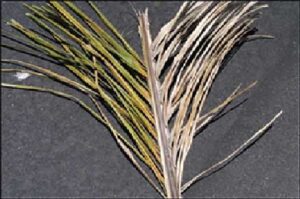
Disease identification and Control
Identifying and controlling diseases in palm plants is crucial to maintaining their health and preventing further damage. Here are some common palm diseases, along with methods for identification and control:
Fusarium Wilt (Fusarium oxysporum)
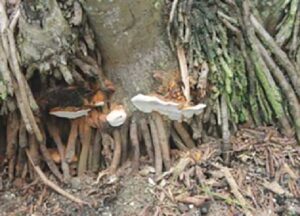
Identification: Symptoms include yellowing and wilting of lower leaves, leaf necrosis, and a general decline in the palm’s overall health. The lower leaves often droop and die, while the spear leaf may remain green.
Control: There is no known cure for Fusarium wilt in palm trees. Promptly remove and destroy infected palms to prevent the spread of the disease. Use disease-free planting material and avoid planting susceptible palm species in areas where the disease is prevalent. Because there is no cure for the disease, the only course of action is careful management of the tree, unless you elect to remove it entirely.
Ganoderma Butt Rot (Ganoderma zonatum)
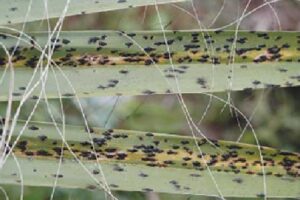
Identification: Symptoms include the gradual decline of the palm, the appearance of conks (shelf-like fungal structures) near the base of the trunk, and white fungal mycelium at the base of the palm.
Control: Unfortunately, there is no cure for Ganoderma butt rot. Infected palms should be removed and destroyed to prevent the spread of the disease. Avoid injuring the palm’s trunk, as wounds create entry points for the fungus.
Diamond Scale (Phoenicococcus marlatti)
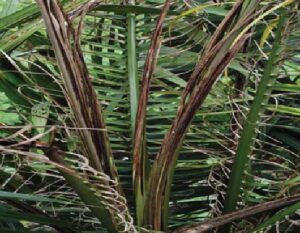
Identification: Diamond scale is a scale insect that infests palm trees. It appears as small, brown, diamond-shaped scales on the fronds and trunk. Heavy infestations can cause yellowing, stunted growth, and decline in the palm’s overall health.
Control: Remove and destroy heavily infested fronds. Use horticultural oil or insecticidal soap to control small-scale populations. Systemic insecticides with copper may also be used, following the instructions provided.
Bud Rot (Phytophthora palmivora)
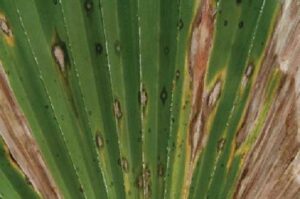
Identification: Symptoms include the collapse and decay of the spear leaf or bud, along with a foul odor. The bud may turn brown or black, and the palm’s overall health declines.
Control: Improve drainage to prevent waterlogging and avoid overwatering. Remove and destroy infected palms, including the entire root ball. Spray 0.25% Copper oxychloride or 1 % Bordeaux mixture on the crown of the neighbouring palms as a prophylactic measure before the onset of monsoon.
Leaf Spot Diseases (Various pathogens)
Identification: Leaf spot diseases manifest as small, circular or irregular spots on the palm’s leaves. The spots may be yellow, brown, or black and may have a yellow halo. Severe infections can cause defoliation and weaken the palm.
Control: Prune and destroy affected leaves. Maintain good air circulation by avoiding overcrowding of palm trees. Avoid overhead irrigation, as it promotes leaf wetness. If the damage becomes severe, fungicidal sprays containing copper can be used. If palm fruits are used for food purposes, copper fungicides are the only approved.
Insect and pest identification and control
Identifying and controlling insect pests in palm plants is crucial to maintaining their health and preventing damage. Here are some common insect pests that can affect palm plants, along with methods for identification and control:
Red Palm Weevil (Rhynchophorus ferrugineus)
Identification: Adult weevils are large, reddish-brown beetles with a long snout. Larvae are creamy white, legless grubs found inside the trunk, causing damage and eventually leading to wilting and death of the palm.
Control: Preventive measures include inspecting and removing infested palms, especially those showing signs of wilting. Through the topmost holes, pour 1% carbaryl (20gm/lt) or 0.2% trichlorfon @ one litre per palm using a funnel. Then plug this hole also. If needed repeat after one week. When the pest infestation is through the crown, clean the crown and slowly pour the insecticidal suspension
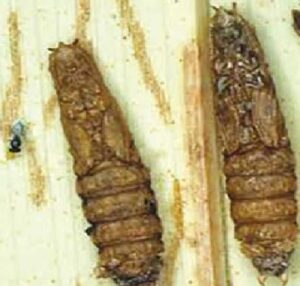
Palm Leaf Beetle (Brontispa longissima)
Identification: Adult beetles are small, metallic blue-black insects. Larvae are cream-colored grubs that feed on the undersides of palm leaves, causing skeletonization and damage.
Control: Prune and destroy affected fronds. Introduce natural predators such as parasitic wasps or beetles. Insecticidal soaps or the recommended insecticide is carbaryl. A few drops of an agricultural wetting agent should be added to the diluted insecticide.
Palm Aphids (Various species)
Identification: Aphids are small, soft-bodied insects that can be green, black, brown, or red. They cluster on young palm leaves, sucking sap and causing distortion, yellowing, and stunted growth.
Control: Use a strong stream of water to dislodge aphids from leaves. Encourage natural predators such as ladybugs or lacewings. Insecticidal soaps or horticultural oils can be applied following the product instructions. Acephate (Isotox, Orthene) is the most widely available systemic insecticide. Dimethoate (Cygon) is less commonly available and is mostly used for aphids on evergreens.
Spider Mites (Tetranychus spp.)
Identification: Spider mites are tiny pests that are difficult to see with the naked eye. They usually appear as tiny specks moving on the undersides of palm leaves. Infested leaves develop yellow stippling, and fine webbing may be visible.
Control: Increase humidity by misting leaves or placing the palm in a more humid environment. Introduce natural predators like predatory mites or use miticides specifically labeled for spider mites on palms. Miticide, also called Acaricide, any chemical substance used to control mites or ticks (especially species that damage ornamental or food plants), which are not susceptible to commonly used insecticides. Azobenzene, dicofol, ovex, and tetradifon are commonly used miticides.
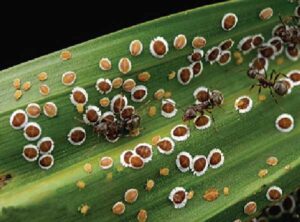
Palm Scale Insects (Various species)
Identification: Scale insects appear as small, immobile bumps on the fronds or trunk of the palm. They can be brown, black, or tan in color. Heavy infestations can cause yellowing, stunted growth, and decline in the palm’s overall health.
Control: Gently scrub infested areas with a soft brush dipped in soapy water. Horticultural oil or insecticidal soaps can be used to suffocate and control scale insects.
It’s important to monitor your palm plants regularly for signs of insect pests and take action at the early stages of infestation. Integrated pest management (IPM) practices, such as cultural controls, biological controls, and targeted pesticide use, can help manage insect pests effectively while minimizing environmental impact.
Conclusion
In conclusion, ornamental palm plants are highly valued for their aesthetic appeal, adding a touch of tropical beauty to landscapes and gardens. They come in various species, each with its own unique features, growth habits, and visual characteristics. Ornamental palms are versatile and can be used in a variety of settings, including gardens, parks, public spaces, and indoor environments. They bring a sense of elegance, relaxation, and cultural significance to their surroundings.
To ensure the health and vitality of ornamental palms, proper care and maintenance are essential. This includes providing well-drained soil, appropriate sunlight exposure, regular watering, and addressing any disease or pest issues promptly. While ornamental palms are primarily cultivated for their ornamental value, certain palm species have been utilized in traditional medicine for various purposes.



